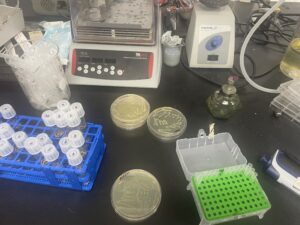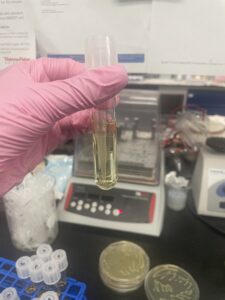Harvesting pDNA
Hello everyone! Last week, I initiated a new transfection for Flo with MAL and OE33 with Axl. I quickly realized that we did not have enough Axl pDNA.
Thus, we needed to harvest more pDNA. Plasmid DNA, typically abbreviated as pDNA, refers to small, circular DNA molecules found in bacteria and other microorganisms. They can replicate independently of chromosomal DNA and often carry non-essential genes for the organism’s survival.
To replenish our Axl pDNA stock, we utilized bacteria stocks containing the Axl pDNA from the -80 degrees Celsius freezer to streak agar plates treated with ampicillin. The presence of ampicillin prevents contamination as the bacteria are resistant to it. Additionally, we took precautions to work near an open flame to minimize contamination risks.
The following day, we selected isolated colonies using a pipet tip. We transferred them into 6 mL tubes containing LB Broth and another antibiotic, such as ampicillin, to ensure only bacteria with the desired gene could grow. These tubes were placed on a shaker overnight at 200 rpm at 37 degrees Celsius, optimal conditions for bacterial growth.



The subsequent day, the lab technician isolated the pDNA using the QIAamp DNA Mini Kit.
Next week, we plan to proceed with transfecting the newly harvested pDNA. Additionally, we aim to commence inhibition studies.
Furthermore, I had the opportunity to visit TGen last week, where I gained insights into data analysis techniques commonly employed in genetics.
Thank you for reading!
